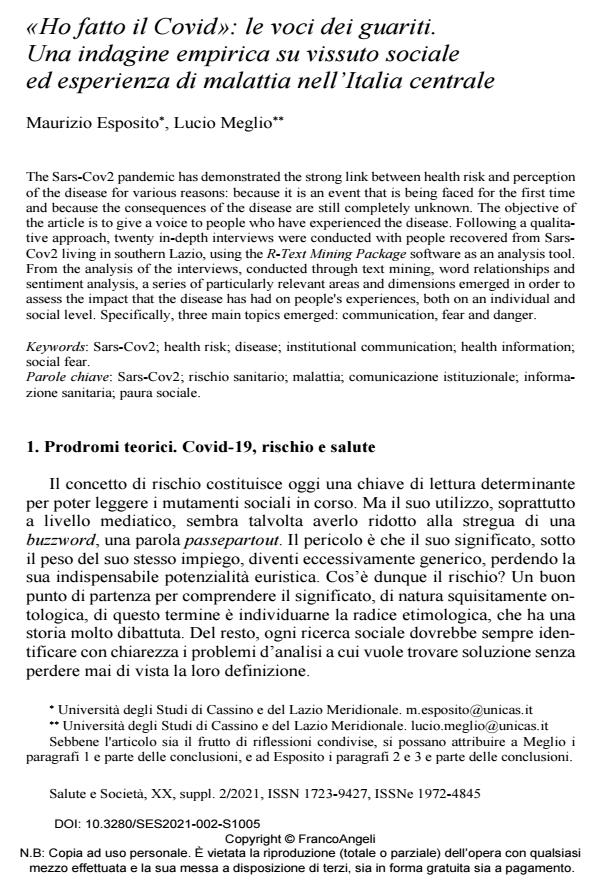«Ho fatto il Covid»: le voci dei guariti. Una indagine empirica su vissuto sociale ed esperienza di malattia nell’Italia centrale
Journal title SALUTE E SOCIETÀ
Author/s Maurizio Esposito, Lucio Meglio
Publishing Year 2021 Issue 2021/suppl. 2
Language Italian Pages 17 P. 68-84 File size 381 KB
DOI 10.3280/SES2021-002-S1005
DOI is like a bar code for intellectual property: to have more infomation
click here
Below, you can see the article first page
If you want to buy this article in PDF format, you can do it, following the instructions to buy download credits

FrancoAngeli is member of Publishers International Linking Association, Inc (PILA), a not-for-profit association which run the CrossRef service enabling links to and from online scholarly content.
The Sars-Cov2 pandemic has demonstrated the strong link between health risk and perception of the disease for various reasons: because it is an event that is being faced for the first time and because the consequences of the disease are still completely unknown. The objective of the article is to give a voice to people who have experienced the disease. Following a qualitative approach, twenty in-depth interviews were conducted with people recovered from Sars- Cov2 living in southern Lazio, using the R-Text Mining Package software as an analysis tool. From the analysis of the interviews, conducted through text mining, word relationships and sentiment analysis, a series of particularly relevant areas and dimensions emerged in order to assess the impact that the disease has had on people's experiences, both on an individual and social level. Specifically, three main topics emerged: communication, fear and danger.
Keywords: Sars-Cov2; health risk; disease; institutional communication; health information; social fear.
- Ardigò A. (1997). Società e salute. Lineamenti di sociologia sanitaria. Milano: FrancoAngeli.
- Beck U. (1986). Risikogesellschaft. Auf dem Weg in eine andere Moderne. Frankfurt am Main: Suhrkamp (trad. it.: La società del rischio. Verso una nuova modernità, 2000. Roma: Carocci).
- Boudon R. (1977). Effects pervers et ordre social. Paris: Presses Universitaires de France.
- Bucchi M., Neresini F. (2001). Sociologia della salute. Roma: Carocci.
- Cersosimo G. (2014). La scoperta della salute. Forme, relazioni e interazioni della comunicazione sanitaria. Napoli: Liguori. Cheung G., Rivera-Rodriguez C., Martinez-Ruiz A., Ma’u1 E., Ryan B., Burholt V., Bissielo A., Meehan B. (2020). Impact of COVID-19 on the health and psychosocial status of vulnerable older adults: study protocol for an observational study. BMC Public Health, 20.
- Cipolla C., Corposanto C., Tousijn W. (2006). I medici di medicina generale in Italia. Milano: FrancoAngeli.
- Douglas M. (1993). Purezza e Pericolo. Bologna: II Mulino [eds. orig.: 1966].
- Douglas M. (1991). Come percepiamo il pericolo. Antropologia del rischio. Milano: Feltrinelli [eds. orig.: 1985].
- Douglas M. (1996). Rischio e colpa. Bologna: II Mulino.
- Esposito, M. (2019). Innovazione sociale e sostenibilità del Servizio sanitario nazionale, un inquadramento sociologico. Salute e Società, XVIII(2): 30-39. DOI: 10.3280/SES2019-00200
- Esposito, M., Addessi, E. (2020). Il servizio sociale in Italia al tempo della pandemia.
- Per una presa in carico globale delle fragilità sociali. Democrazia e Diritti
- sociali, Fascicolo speciale, Cassino. Genova A., Favretto A.R., Clemente C., Servetti D., Lombardini S. (2021). Assistenza primaria e Covid-19: MMG e USCA. In: Vicarelli G., Giarelli G., a cura di, Libro Bianco. Il Servizio Sanitario Nazionale e la pandemia da Covid-19. Problemi e proposte. Milano: FrancoAngeli.
- Giddens A. (1990). The Consequences of Modernity. Cambridge: Polity Press.
- Illich I. (1976). Medical nemesis. The expropriation of health. London: Calder & Boyars.
- Ligi G. (2009). Antropologia dei disastri. Bari: Laterza.
- Luhmann N. (1996). Sociologia del rischio. Milano: Mondadori.
- Lupton D. (1995). The Imperative of Health. London: Sage.
- Lupton D. (2003). Il rischio. Percezione, simboli, culture. Bologna: Il Mulino [eds. orig.: 1999].
- Mangone E. (2020). La comunicazione del rischio: la pandemia da Covid-19. Mediascapes Journal, 15:132-142.
- Meglio L. (2019). Communication in emergency situation. Ratio sociologica, 12: 5-17.
- Pagano U. (2001). La comunicazione nelle situazioni di rischio. Quaderni di sociologia, 25.
- Park S.Y., Kim B., Sik Jung D., In Jung S., Sup W., Kim S., Peck K.R., Chang H. (2020). Psychological distress among infectious disease physicians during the response to the COVID-19 outbreak in the Republic of Korea. BMC Public Health, 20.
- Sandman P. M. (1987). Risk communication: facing public outrage. Epa Journal, 13. DOI: 10.1177/089331898800200200
- Sorokin P.A. (2010). Man and society in calamity. Brunswick: Transaction Publishers. [eds. orig.: 1942].
- Starr C. (1969). Social benefit versus technological risk. Science, 165: 1232-1238. Touraine A. (2004). On the Frontier of Social Movements. Current sociology, 4. DOI: 10.1177/001139210404349
- World Health Organization - WHO (2008). Outbreak communication planning guide. Ginevra: WHO.
Maurizio Esposito, Lucio Meglio, «Ho fatto il Covid»: le voci dei guariti. Una indagine empirica su vissuto sociale ed esperienza di malattia nell’Italia centrale in "SALUTE E SOCIETÀ" suppl. 2/2021, pp 68-84, DOI: 10.3280/SES2021-002-S1005